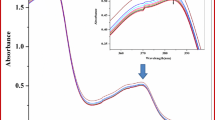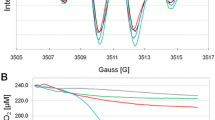Abstract
As a replacement for chlorofluorocarbons that cause ozone depletion, 1-bromopropane has been widely used in work place. In the present study, the formation of N 7-guanine adduct in DNA by 1-bromopropane was evaluated in vitro to elucidate the possible mechanism of its toxic action. N 7-Propyl guanine was chemically synthesized and structurally characterized by NMR, UV, HPLC, and liquid chromatographyelectrospray ionization mass spectrometry (LC- ESI MS) for using as a reference standard. An incubation of 2ʹ-deoxyguanosine with 1-bromopropane produced N 7-propyl adduct, which was identified by UV, HPLC and ESI-MS. In addition, N7-guanine adduct was also identified from the incorporation of calf thymus DNA with 1-bromopropane at the physiological condition by LC-ESI MS. Furthermore, the production of adduct was proportional to the amounts of 1-bromopropane used. These results indicated that the molecular mechanism underlying toxic effects of 1-bromopropane would be associated with the adduct formation on DNA at least in part.
Similar content being viewed by others
References
Takeuchi, Y., Ichihara, G. & Kamijima, M. A review on toxicity of 2-bromopropane: mainly on its reproductive toxicity. J Occup Health 39:179–191 (1997).
Kim, Y. et al. Hematopoietic and reproductive hazards o Korean electronic workers exposed to solvents containing 2-bromopropane. Scand J Work Environ Health 39:387–391 (1996).
Park, J. S. et al. An outbreak of hematopoietic and reproductive disorders due to solvents containing 2-bromopropane in an electronic factory South Korea: epidemiological survey. J Occup Health 39:138–143 (1997).
Yu, I. J. et al. The occupational exposure level (OEL) for 2-bromopropane: the first OEL established by Korea. Appl Occup Environ Hyg 14:356–358 (1999).
Maeng, S. H. & Yu, I. J. Mutagenicity of 2-bromopropane. Ind Health 35:87–95 (1997).
Ichihara, G. Neuro-reproductive toxicities of 1-bromopropane and 2-bromopropane. Int Arch Occup Environ Health 78:79–96 (2005).
Barber, E. D., Donish, W. H. & Mueller, K. R. A procedure for the quantitative measurement of the mutagenicity of volatile liquids in th Ames Salmonella/ microsome assay. Mutat Res 90:31–48 (1981).
Lee, S. K. et al. Role of glutathione conjugation in the hepatotoxicity and immunotoxicity induced by 1-bromopropane in female BALB/c mice. J Appl Toxicol 27:358–367 (2007).
Sekiguchi, S., Suda, M., Zhai, Y. L. & Honma, T. Effects of 1-bromopropane, 2-bromopropane, and 1,2-dichloropropane on the estrous cycle and ovulation in F344 rats. Toxicol Lett 126:41–49 (2002).
Zhao, L. X. et al. Synthesis, characterization and in vitro identification of N7-guanine adduct of 2-bromopropane. Arch Pharm Res 25:39–44 (2002).
Yu, X. et al. Neurotoxicity of 2-bromopropane and 1-bromopropane, alternative solvents for chlorofluorocarbons. Environ Res 85:48–52 (2001).
Thapa, P. et al. Depurination of dA and dG induced by 2-bromopropane at the physiological condition. J Appl Pharmacol 15:224–229 (2007).
Sherchan, J., Choi, H. & Lee, E. S. Depurination of nucleosides and calf thymus DNA induced by 2-bromopropane at the physiological condition. Bull Korean Chem Soc 30:2309–2317 (2009).
Lee, S. K. et al. Hepatotoxic effect of 1-bromopropane and its conjugation with glutathione in male ICR mice. Arch Pharm Res 28:1177–1182 (2005).
Han, E. H. et al. 1-Bromopropane up-regulates cyclooxygenase-2 expression via NF-κB and C/EBP activation in murine macrophages. Food Chem Toxicol 50:1616–1622 (2012).
Kim, D. H. & Guengerich, F. P. Formation of the DNA adduct S-[2-(N7-guanyl)ethyl]glutathione from ethylene dibromide: effects of modulation of glutathione and glutathione S-transferase levels and lack of a role for sulfation. Carcinogenesis 11:419–424 (1990).
Kim, D. H., Humphreys, W. G. & Guengerich, F. P. Characterization of S-[2-(N1-adenyl)ethyl]glutathione as an adduct formed in RNA and DNA from 1,2-dibromoethane. Chem Res Toxicol 3:587–594 (1990).
Author information
Authors and Affiliations
Corresponding authors
Rights and permissions
About this article
Cite this article
Thapa, P., Kim, EK., Nepal, M.R. et al. Identification of a N 7-guanine adduct of 1-bromopropane in calf thymus DNA by mass spectrometry. Mol. Cell. Toxicol. 12, 7–14 (2016). https://doi.org/10.1007/s13273-016-0002-5
Received:
Accepted:
Published:
Issue Date:
DOI: https://doi.org/10.1007/s13273-016-0002-5




